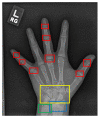Intelligent Bone Age Assessment: An Automated System to Detect a Bone Growth Problem Using Convolutional Neural Networks with Attention Mechanism
- PMID: 33923215
- PMCID: PMC8146101
- DOI: 10.3390/diagnostics11050765
Intelligent Bone Age Assessment: An Automated System to Detect a Bone Growth Problem Using Convolutional Neural Networks with Attention Mechanism
Abstract
Skeletal bone age assessment using X-ray images is a standard clinical procedure to detect any anomaly in bone growth among kids and babies. The assessed bone age indicates the actual level of growth, whereby a large discrepancy between the assessed and chronological age might point to a growth disorder. Hence, skeletal bone age assessment is used to screen the possibility of growth abnormalities, genetic problems, and endocrine disorders. Usually, the manual screening is assessed through X-ray images of the non-dominant hand using the Greulich-Pyle (GP) or Tanner-Whitehouse (TW) approach. The GP uses a standard hand atlas, which will be the reference point to predict the bone age of a patient, while the TW uses a scoring mechanism to assess the bone age using several regions of interest information. However, both approaches are heavily dependent on individual domain knowledge and expertise, which is prone to high bias in inter and intra-observer results. Hence, an automated bone age assessment system, which is referred to as Attention-Xception Network (AXNet) is proposed to automatically predict the bone age accurately. The proposed AXNet consists of two parts, which are image normalization and bone age regression modules. The image normalization module will transform each X-ray image into a standardized form so that the regressor network can be trained using better input images. This module will first extract the hand region from the background, which is then rotated to an upright position using the angle calculated from the four key-points of interest. Then, the masked and rotated hand image will be aligned such that it will be positioned in the middle of the image. Both of the masked and rotated images will be obtained through existing state-of-the-art deep learning methods. The last module will then predict the bone age through the Attention-Xception network that incorporates multiple layers of spatial-attention mechanism to emphasize the important features for more accurate bone age prediction. From the experimental results, the proposed AXNet achieves the lowest mean absolute error and mean squared error of 7.699 months and 108.869 months2, respectively. Therefore, the proposed AXNet has demonstrated its potential for practical clinical use with an error of less than one year to assist the experts or radiologists in evaluating the bone age objectively.
Keywords: X-ray image; attention mechanism; bone growth disorder; convolutional neural network; regression network.
Conflict of interest statement
The authors declare no conflict of interest.
Figures








Similar articles
-
Clinical Validation of a Deep Learning-Based Hybrid (Greulich-Pyle and Modified Tanner-Whitehouse) Method for Bone Age Assessment.Korean J Radiol. 2021 Dec;22(12):2017-2025. doi: 10.3348/kjr.2020.1468. Epub 2021 Oct 1. Korean J Radiol. 2021. PMID: 34668353 Free PMC article.
-
Deep learning for automated skeletal bone age assessment in X-ray images.Med Image Anal. 2017 Feb;36:41-51. doi: 10.1016/j.media.2016.10.010. Epub 2016 Oct 29. Med Image Anal. 2017. PMID: 27816861
-
MABAL: a Novel Deep-Learning Architecture for Machine-Assisted Bone Age Labeling.J Digit Imaging. 2018 Aug;31(4):513-519. doi: 10.1007/s10278-018-0053-3. J Digit Imaging. 2018. PMID: 29404850 Free PMC article.
-
Hand X-ray in pediatric endocrinology: Skeletal age assessment and beyond.Indian J Endocrinol Metab. 2014 Nov;18(Suppl 1):S63-71. doi: 10.4103/2230-8210.145076. Indian J Endocrinol Metab. 2014. PMID: 25538880 Free PMC article. Review.
-
Are the new automated methods for bone age estimation advantageous over the manual approaches?Pediatr Endocrinol Rev. 2014 Dec;12(2):200-5. Pediatr Endocrinol Rev. 2014. PMID: 25581985 Review.
Cited by
-
Design of an Incremental Music Teaching and Assisted Therapy System Based on Artificial Intelligence Attention Mechanism.Occup Ther Int. 2022 Jun 16;2022:7117986. doi: 10.1155/2022/7117986. eCollection 2022. Occup Ther Int. 2022. Retraction in: Occup Ther Int. 2023 Aug 16;2023:9879185. doi: 10.1155/2023/9879185. PMID: 35821708 Free PMC article. Retracted.
-
Texture Analysis for the Bone Age Assessment from MRI Images of Adolescent Wrists in Boys.J Clin Med. 2023 Apr 7;12(8):2762. doi: 10.3390/jcm12082762. J Clin Med. 2023. PMID: 37109098 Free PMC article.
-
AE-BoNet: A Deep Learning Method for Pediatric Bone Age Estimation using an Unsupervised Pre-Trained Model.J Biomed Phys Eng. 2025 Jun 1;15(3):271-280. doi: 10.31661/jbpe.v0i0.2304-1609. eCollection 2025 Jun. J Biomed Phys Eng. 2025. PMID: 40510303 Free PMC article.
References
-
- Iglovikov V.I., Rakhlin A., Kalinin A.A., Shvets A.A. Deep Learning in Medical Image Analysis and Multimodal Learning for Clinical Decision Support. Springer; Cham, Switzerland: 2018. Paediatric bone age assessment using deep convolutional neural networks; pp. 300–308.
-
- Hao P., Chen Y., Chokuwa S., Wu F., Bai C. Pacific Rim Conference on Multimedia. Springer; Cham, Switherland: 2018. Skeletal bone age assessment based on deep convolutional neural networks; pp. 408–417.
Grants and funding
LinkOut - more resources
Full Text Sources
Other Literature Sources

